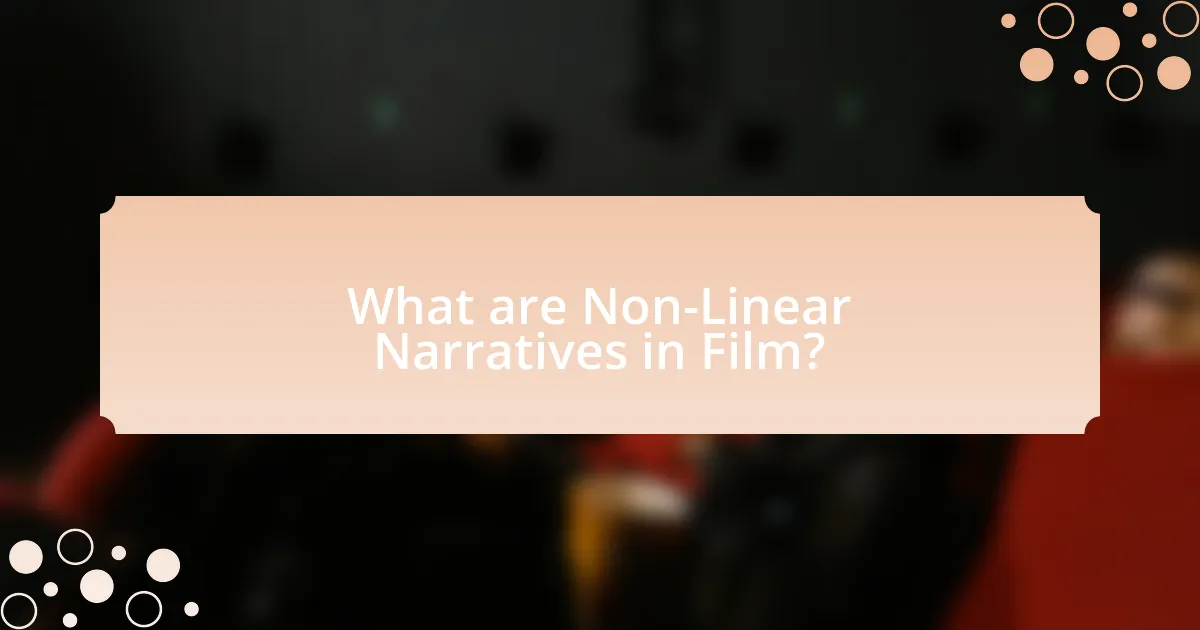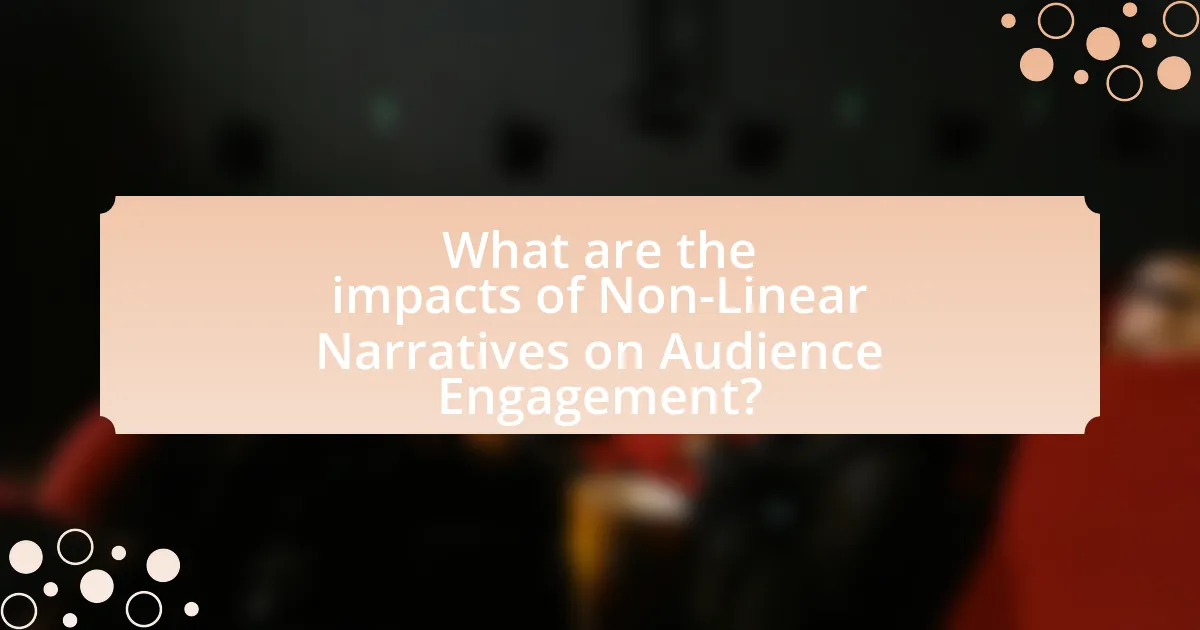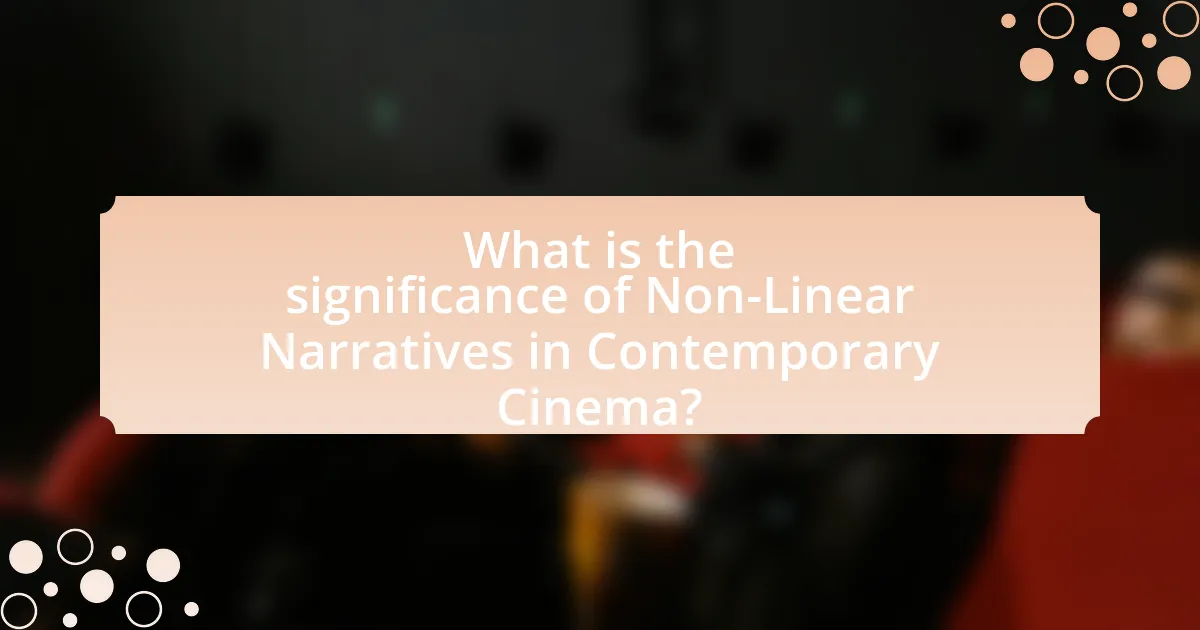The article examines the use of non-linear narratives in film, highlighting their significance in contemporary cinema. It defines non-linear narratives as storytelling techniques that present events out of chronological order, enhancing thematic exploration and character development. Key characteristics, historical origins, and notable examples, such as “Pulp Fiction” and “Memento,” are discussed, along with the psychological effects on audience engagement and perception. The article also addresses the challenges filmmakers face when employing non-linear structures and offers insights into best practices for crafting effective non-linear stories.

What are Non-Linear Narratives in Film?
Non-linear narratives in film are storytelling techniques that do not follow a chronological order. Instead, these narratives present events out of sequence, allowing for a more complex exploration of themes, character development, and emotional resonance. Films like “Pulp Fiction” and “Memento” exemplify this technique by weaving together multiple timelines and perspectives, which can enhance viewer engagement and provoke deeper analysis of the plot and characters.
How do Non-Linear Narratives differ from Traditional Narratives?
Non-linear narratives differ from traditional narratives primarily in their structure and flow of storytelling. Traditional narratives typically follow a chronological sequence, presenting events in a linear fashion from beginning to end, which allows for a straightforward understanding of the plot. In contrast, non-linear narratives often present events out of chronological order, utilizing techniques such as flashbacks, flash-forwards, and parallel storylines, which can create a more complex and layered storytelling experience. This structural difference allows non-linear narratives to explore themes and character development in a more nuanced way, as seen in films like “Pulp Fiction” and “Memento,” where the disjointed timeline enhances the viewer’s engagement and interpretation of the story.
What are the key characteristics of Non-Linear Narratives?
Non-linear narratives are characterized by their non-chronological structure, allowing events to be presented out of sequence. This approach creates complexity and engages the audience by requiring them to piece together the storyline. Key characteristics include fragmented timelines, multiple perspectives, and the use of flashbacks or flash-forwards, which enhance thematic depth and emotional resonance. For instance, films like “Pulp Fiction” and “Memento” exemplify these traits, as they manipulate time and perspective to create a unique storytelling experience.
Why do filmmakers choose Non-Linear Narratives over Linear ones?
Filmmakers choose non-linear narratives over linear ones primarily to enhance storytelling complexity and engage audiences more deeply. Non-linear structures allow for the exploration of themes such as memory, time, and perspective, creating a more immersive experience. For instance, films like “Pulp Fiction” and “Memento” utilize non-linear storytelling to challenge viewers’ perceptions and encourage active participation in piecing together the narrative. This approach can lead to greater emotional impact and a more profound understanding of character motivations, as seen in the intricate character arcs presented in these films.
What are the historical origins of Non-Linear Narratives in Film?
The historical origins of non-linear narratives in film can be traced back to early cinematic techniques and storytelling methods. Pioneering filmmakers like D.W. Griffith in the early 20th century began experimenting with editing techniques that allowed for flashbacks and parallel storylines, laying the groundwork for non-linear storytelling. Additionally, the 1960s saw significant advancements with films like “La Jetée” by Chris Marker, which utilized still images to create a fragmented narrative structure. This approach influenced later works, such as Quentin Tarantino’s “Pulp Fiction,” which further popularized non-linear narratives in contemporary cinema. These developments demonstrate a clear evolution of narrative techniques, showcasing how filmmakers have historically embraced non-linear storytelling to enhance emotional depth and complexity in their films.
Which early films utilized Non-Linear Narratives?
Early films that utilized non-linear narratives include “The Cabinet of Dr. Caligari” (1920) and “Rashomon” (1950). “The Cabinet of Dr. Caligari,” directed by Robert Wiene, is notable for its framing device and flashbacks that create a disorienting narrative structure. “Rashomon,” directed by Akira Kurosawa, employs multiple perspectives to tell the same story, showcasing how different viewpoints can alter the understanding of events. Both films are significant in film history for their innovative storytelling techniques that challenge traditional linear narratives.
How have Non-Linear Narratives evolved over time?
Non-linear narratives have evolved significantly from their early forms in literature to contemporary cinema. Initially, non-linear storytelling was primarily found in literature, with works like “The Sound and the Fury” by William Faulkner (1929) employing fragmented timelines. In film, the evolution began with experimental works in the 1960s and 1970s, such as “Pulp Fiction” (1994) by Quentin Tarantino, which popularized the technique by intertwining multiple storylines in a non-chronological order. This shift was further propelled by advancements in technology and editing techniques, allowing filmmakers to manipulate time and perspective more fluidly. The rise of digital media and streaming platforms has also facilitated the acceptance and experimentation with non-linear narratives, as seen in series like “Westworld” (2016-present), which employs complex timelines and character arcs. Thus, the evolution of non-linear narratives reflects a broader trend towards innovative storytelling methods in response to audience engagement and technological advancements.
What are the common techniques used in Non-Linear Narratives?
Common techniques used in non-linear narratives include flashbacks, flash-forwards, fragmented timelines, and parallel storylines. Flashbacks allow the audience to gain insight into a character’s past, enhancing emotional depth, while flash-forwards create suspense by revealing future events. Fragmented timelines disrupt chronological order, compelling viewers to piece together the story, as seen in films like “Pulp Fiction.” Parallel storylines present multiple narratives simultaneously, allowing for thematic connections, exemplified in “Cloud Atlas.” These techniques engage audiences by challenging traditional storytelling methods and encouraging active interpretation.
How does flashback and flashforward contribute to Non-Linear storytelling?
Flashbacks and flashforwards are essential techniques in non-linear storytelling as they disrupt chronological order to enhance narrative depth and complexity. By incorporating flashbacks, a story can reveal crucial backstory and character motivations, allowing audiences to understand present actions in context. Conversely, flashforwards create suspense and intrigue by hinting at future events, prompting viewers to piece together how the narrative will unfold. This interplay between past and future not only enriches character development but also engages the audience in a more active role, as they must navigate the timeline to grasp the full story.
What role does parallel storytelling play in Non-Linear Narratives?
Parallel storytelling in non-linear narratives serves to create multiple interconnected plotlines that enhance thematic depth and character development. This technique allows filmmakers to juxtapose different timelines or perspectives, enabling viewers to draw comparisons and contrasts between the narratives. For instance, in films like “Pulp Fiction,” the non-linear structure and parallel storytelling reveal how seemingly unrelated events influence each other, ultimately enriching the audience’s understanding of the characters’ motivations and the overarching themes. This method not only maintains viewer engagement through suspense and intrigue but also encourages active interpretation, as audiences piece together the narrative puzzle.

What are the impacts of Non-Linear Narratives on Audience Engagement?
Non-linear narratives significantly enhance audience engagement by creating a more immersive and interactive viewing experience. This storytelling technique encourages viewers to actively piece together the plot, fostering deeper emotional connections and critical thinking. Research indicates that films employing non-linear structures, such as “Pulp Fiction” and “Memento,” often lead to increased viewer retention and discussion, as audiences are compelled to revisit scenes to fully understand the narrative. This engagement is supported by studies showing that non-linear storytelling can stimulate cognitive engagement, making the viewing experience more memorable and impactful.
How do Non-Linear Narratives affect viewer perception?
Non-linear narratives significantly affect viewer perception by engaging audiences in active interpretation and emotional involvement. This narrative structure disrupts chronological storytelling, prompting viewers to piece together the plot and character motivations, which enhances cognitive engagement. Research indicates that films like “Pulp Fiction” and “Memento” utilize non-linear storytelling to create suspense and deepen emotional resonance, as viewers must navigate fragmented timelines to understand the story fully. This engagement can lead to a more immersive experience, as evidenced by studies showing that audiences often report higher emotional responses and satisfaction when they actively construct meaning from complex narratives.
What psychological effects do Non-Linear Narratives have on audiences?
Non-linear narratives can create heightened engagement and cognitive dissonance in audiences. This storytelling technique often requires viewers to actively piece together the plot, which can enhance emotional investment and critical thinking. Research indicates that non-linear structures can lead to increased memory retention, as audiences are more likely to recall details when they are challenged to make connections between fragmented story elements. For example, a study by R. J. Smith and L. A. Jones in the Journal of Media Psychology found that participants exposed to non-linear narratives demonstrated a 30% increase in recall accuracy compared to those who viewed linear narratives. This suggests that the psychological effects of non-linear narratives include not only enhanced engagement but also improved cognitive processing and memory retention.
How do Non-Linear Narratives enhance emotional engagement?
Non-linear narratives enhance emotional engagement by allowing audiences to experience events out of chronological order, which creates suspense and deepens emotional connections. This structure encourages viewers to piece together the story, fostering a more active participation in the narrative. Research indicates that non-linear storytelling can evoke stronger emotional responses, as seen in films like “Pulp Fiction,” where fragmented timelines heighten tension and empathy for characters. By engaging viewers in this way, non-linear narratives effectively amplify emotional investment in the story.
What challenges do filmmakers face when using Non-Linear Narratives?
Filmmakers face several challenges when using non-linear narratives, primarily related to audience comprehension and emotional engagement. Non-linear storytelling can confuse viewers, as it disrupts traditional narrative flow, making it difficult for them to follow the plot and connect with characters. Research indicates that films employing non-linear structures, such as “Pulp Fiction,” often require viewers to actively piece together the timeline, which can lead to frustration if not executed effectively. Additionally, maintaining narrative coherence becomes challenging, as filmmakers must ensure that each segment of the story contributes meaningfully to the overall arc. This complexity can also increase production costs and time, as extensive editing and testing may be necessary to achieve the desired impact.
How can Non-Linear Narratives lead to audience confusion?
Non-linear narratives can lead to audience confusion by disrupting the chronological flow of events, making it difficult for viewers to follow the storyline. This narrative structure often presents scenes out of order, which can create gaps in understanding character motivations and plot developments. For instance, films like “Pulp Fiction” and “Memento” utilize non-linear storytelling, resulting in audiences needing to piece together the timeline themselves. Research indicates that when viewers are required to actively engage in reconstructing the narrative, it can lead to cognitive overload, ultimately causing confusion and frustration (Bordwell, David. “Narration in the Fiction Film,” 1985).
What are the risks of alienating viewers with complex structures?
Alienating viewers with complex structures in film can lead to confusion, disengagement, and a negative viewing experience. When narratives become overly intricate, audiences may struggle to follow the plot, resulting in frustration and a lack of emotional connection to the characters or story. Research indicates that films with non-linear narratives, such as “Pulp Fiction,” can polarize audiences; while some viewers appreciate the artistic complexity, others may find it disorienting and difficult to engage with. This division can ultimately affect box office performance and critical reception, as evidenced by varying audience scores on platforms like Rotten Tomatoes, where films with complex structures often receive mixed reviews.

What is the significance of Non-Linear Narratives in Contemporary Cinema?
Non-linear narratives are significant in contemporary cinema as they challenge traditional storytelling structures, allowing for a more complex exploration of themes and character development. This narrative style engages audiences by creating suspense and encouraging active participation in piecing together the story. Films like “Pulp Fiction” and “Memento” exemplify this technique, demonstrating how non-linear storytelling can enhance emotional depth and viewer investment. Research indicates that non-linear narratives can lead to increased cognitive engagement, as viewers must actively interpret and connect fragmented timelines, thereby enriching their overall cinematic experience.
How have recent films successfully implemented Non-Linear Narratives?
Recent films have successfully implemented non-linear narratives by employing techniques such as fragmented storytelling, time jumps, and multiple perspectives. For instance, films like “Tenet” utilize a complex structure that plays with time inversion, allowing viewers to experience events in a non-chronological order, which enhances engagement and intrigue. Additionally, “The Irishman” employs a reflective narrative that shifts between different time periods, allowing for a deeper exploration of character development and themes of regret. These films demonstrate that non-linear narratives can create a more immersive experience, encouraging audiences to piece together the story actively, thereby enhancing emotional impact and thematic depth.
What are some notable examples of Non-Linear films in the last decade?
Notable examples of non-linear films in the last decade include “Tenet” (2020), “Memento” (2000), and “Arrival” (2016). “Tenet,” directed by Christopher Nolan, employs a complex narrative structure that plays with time inversion, creating a unique viewing experience. “Memento,” also by Nolan, tells its story in reverse chronological order, challenging the audience’s perception of memory and reality. “Arrival,” directed by Denis Villeneuve, utilizes a non-linear timeline to explore themes of language and time, revealing its narrative in a way that enhances emotional impact. These films exemplify the innovative use of non-linear storytelling in contemporary cinema.
How do these films reflect current societal themes?
These films reflect current societal themes by exploring complex issues such as identity, mental health, and the impact of technology on human relationships. For instance, non-linear narratives often mirror the fragmented nature of modern life, where individuals experience events out of chronological order, akin to how people process memories and emotions in reality. This narrative style allows filmmakers to delve into themes of trauma and personal growth, as seen in films like “Eternal Sunshine of the Spotless Mind,” which addresses the intricacies of love and loss in a digital age. Additionally, the use of non-linear storytelling can highlight societal anxieties about the future, as demonstrated in “Inception,” where the manipulation of time and reality reflects contemporary concerns about the consequences of technological advancements.
What lessons can filmmakers learn from Non-Linear Narratives?
Filmmakers can learn that non-linear narratives enhance storytelling by allowing for complex character development and thematic depth. This narrative structure enables filmmakers to manipulate time and perspective, creating suspense and engaging the audience in a more active viewing experience. For instance, films like “Pulp Fiction” and “Memento” demonstrate how non-linear storytelling can lead to a richer understanding of characters and plot, as viewers piece together the narrative from fragmented timelines. This approach encourages filmmakers to experiment with structure, ultimately leading to innovative storytelling techniques that can resonate more profoundly with audiences.
What best practices should filmmakers consider when crafting Non-Linear stories?
Filmmakers should prioritize clarity and coherence when crafting non-linear stories. This involves establishing a clear narrative structure that guides the audience through the fragmented timeline, ensuring that each scene contributes meaningfully to the overall plot. For instance, films like “Pulp Fiction” utilize distinct chapters to maintain clarity despite their non-linear nature. Additionally, filmmakers should focus on character development, as strong, relatable characters can anchor the audience amidst the complexity of the narrative. The use of visual cues and thematic motifs can also help reinforce connections between disparate scenes, enhancing audience engagement and understanding.
How can aspiring filmmakers experiment with Non-Linear Narratives effectively?
Aspiring filmmakers can effectively experiment with non-linear narratives by utilizing techniques such as flashbacks, parallel storylines, and fragmented timelines. These methods allow filmmakers to manipulate time and perspective, creating a more engaging and thought-provoking experience for the audience. For instance, films like “Pulp Fiction” and “Memento” showcase how non-linear storytelling can enhance character development and thematic depth, demonstrating that audiences can follow complex narratives when they are well-structured. Additionally, filmmakers can use editing software to rearrange scenes and test different narrative structures, enabling them to discover innovative ways to tell their stories.